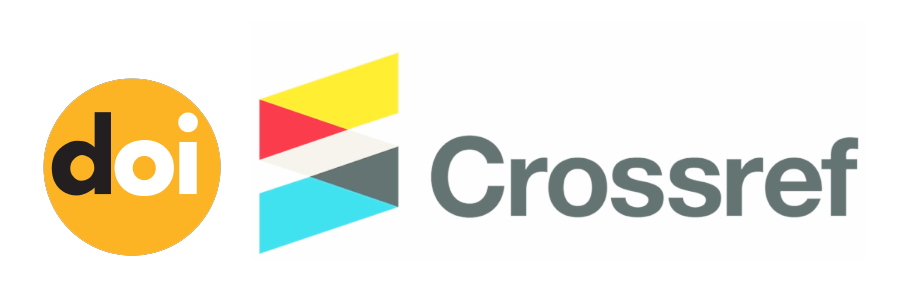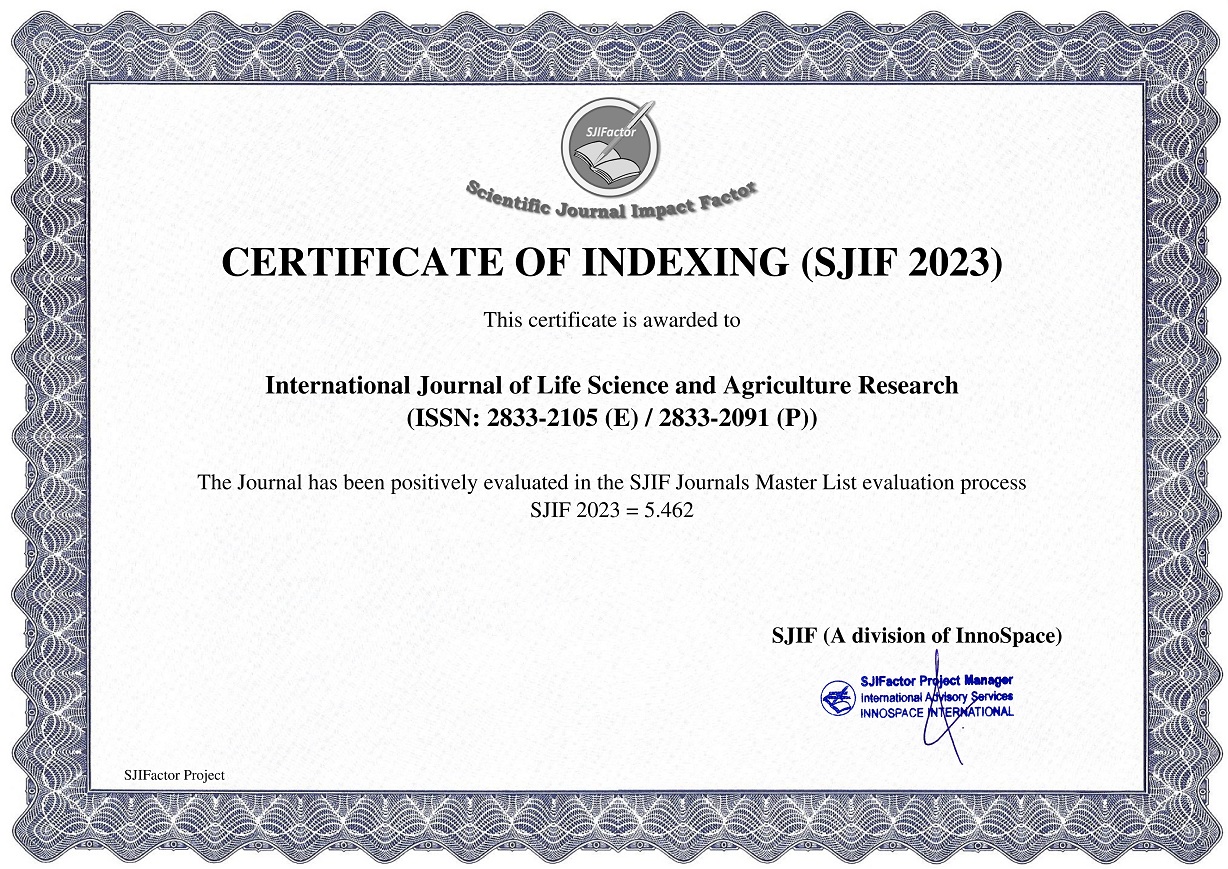Influence of Boiled Cassia Tora Seed Meal on Carcass and Internal Organs Characteristics of Starter Broiler Chickens
DOI:
https://doi.org/10.55677/ijlsar/V03I3Y2024-13Keywords:
Cassia tora, broiler chickens, carcass characteristics, internal organs parametersAbstract
An experiment was conducted to evaluate the effect of 30 minutes boiled Cassia tora seed meal in starter broiler chicken diets on carcass and internal organs characteristics, using one hundred and twenty day-old Hubbard broiler chicks. Five starter broiler chicken diets were formulated such that 30 minutes of boiled Cassia tora seed meal were included at 0%, 5%, 10%, 15% and 20% designated as treatments T1, T2, T3, T4 and T5 respectively. The chicks were randomly divided into five groups of twenty-four (24) chicks each and allocated to the five dietary treatments replicated three times with 8 birds per replicate in a Completely Randomized Design (CRD). The parameters measured were live weight; dressed weight, carcass weight and internal organs weights. Feed and water were given ad libitum throughout the 28 days of the research period. The results showed that all the carcass characteristics parameters measured were not significantly different (P>0.05) across treatment means except for wings which had values ranging from 10.32kg for T 1 to 8.93kg for T2. Live weights were 1165.00kg, 1298.67kg, 1206.60kg, 1158.67kg and 1006.33 kg for birds fed diets T1, T2, T3, T4 and T5. The dressed weights were 1084.67kg, 1194.67kg, 1108.00kg, 1078.00g and 936.00kg for birds fed T1, T2, T3, T4 and T5 diets. The values obtained from the dressing percentage were 93.13%, 91.90%, 91.70%, 93.06% and 92.96% for birds fed T1, T2, T3, T4 and T5 respectively. The result of breast weight numerically showed that birds fed T5 diet had the least value of 21.35kg while birds fed T2 had the highest value 24.57kg.Thigh weight showed that birds fed T5 diet recorded 11.05kgas the lowest value and T2which was 12.24kg as the highest value. Drumstick evaluation showed birds fed T5 as the poorest performed and T4 as the best performed and the back cut values showed T1 as the poorest performed with a weight of 14.12kg and T4 as the best performed with the weight of 15.55kg. Small intestine, large intestine, proventriculus and pancreas had significant differences (P<0.05) among the treatments while supplementing 30 minutes of boiled CTSM in broiler feed at 5% to 20 % inclusion levels had no significant difference (P>0.05):on the heart, liver, kidney, lungs, spleen, empty gizzard and gall bladder across the respective treatments. It was concluded from the results obtained that 30 minutes of boiled Cassia tora seed meal (BCTSM) could be included up to 20% in broiler starter chicken diets without any adverse effects on the carcass and internal organs characteristics.
References
A.O.A.C. (2000). Association of Official Analytical Chemists. Methods of Analysis. 17th Edition, Washington, D.C.
Ani, A.O (2008). The Feeding Value of Processing Velvet Bean (Mucuna pruriens) for Pullet Chicks. Journal of Tropical Agriculture, Food Environment and Extension. 7 (2)149-155.
Assam Esther, Ndelekwute Eugenes and Anthony Okonkwo (2017). Nutritional Evaluation of Sickle Pod (Cassia tora) Seed Meal in Broiler Diets; International Journal of Agriculture Environment and Bio Research. 2(3): 141-153.
Brenes, A., Smith, M, Guener and Marquardt,.R, (1993). Effects of enzymes supplementation on the performance and digestive tract size of broiler chickens fed wheat-and barlery- based diets. Poultry Science.72:1731-1739
Infant-Rodriguez,Salinas-Chavira and Ramirez De Leon,. J.A (2016). Effects of Diets with Different Energy Concentrations on Growth Performance, Carcass Characteristics and Meat Chemical Composition of Broiler Chickens in Dry Tropics.Pp.1376
Onunkwo, D. N. and George, O. S. (2015). Effects of MoringaOleifera meal on the growth performance and carcass characteristics of broiler birds. Journal of Agriculture and Veterinary Science, 8(3):63-66.
Osman, M.A. (2007). Effect of Different Processing Methods on Nutrient Composition, Anti Nutritional Factors and In vitro Protein Digestibility of Dolichos lablab Bean (lablab purpureusi sweet) Pakistan Journal of Nutrition. 6: 299-303.
Osman, M.A. (2007). Effect of Different Processing Methods on Nutrient Composition, Anti Nutritional Factors and In vitro Protein Digestibility of Dolichos lablab Bean (lablab purpureusi sweet) Pakistan Journal of Nutrition. 6: 299-303.
Ukachukwu,S.N., Obioha, F.C. and Madubuike, R.C. (1999). Determination of the true Metabolisable Energy (TME) of Raw and Heat Treated Mucuna cocchinensis using Adult Broilers. Tropical Journal of Animal Science, 3(1), 25-31.
Smiths, C.H.M and Annison, G. (1996). Non-starch Plant Polysaccharides in Broiler Nutrition-towards a physiologically valid approach to their Determination World’s. Journal of poultry Science. 52:203-21.
Umoren, U. E., Essien, A.I., Ukorebi, B. A and Essien, E.B., (2005). Chemical Evaluation of the Seeds of Milletia Obanensis. Food Chemical, 91:195-201.
Vadivel, V. and Janardhanan, K.(2005). Nutritional Characteristics of seven south Indian Wild Legumes. Plant Food in Human Nutrition. 6(2). 69-75.
Vander Poel, A.F.B, and Liener, I.E.(1990). Recent advances of Research in Anti-nutritional factors in legume seeds. Pudoc, Wageningen Pp 6-14.
Yakubu, .B, Mbahi, T.F., Haniel, G. and Wafar, R.J. (2017). Effects of Feeding Cassia obtusifolia Leaf Meal on Growth Performance, Carcass Characteristics and Blood Profile of Broiler Chickens. General Journal of Agricultural Sciences. Volume 7(1): 2276-2284.





